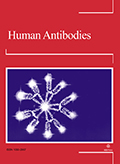Authors: Hashizume, S. | Kamei, M. | Mochizuki, K. | Sato, S. | Kuroda, K. | Kato, M. | Yasumoto, K. | Nakahashi, H. | Hirose, H. | Tai, H. | Okano, H. | Nomoto, K. | Murakami, H.
Article Type:
Research Article
Abstract:
Cytochrome c from various sources, such as Candida krusei , yeast, horse, and cattle, was found to be recognized by human monoclonal antibody HB4C5 specific to lung cancer. Therefore, the cytochrome c was applied to the measurement of antibody amount in patient sera with a similar reactivity to the antibody HB4C5 for serodiagnosis of cancer. The cytochrome c from Candida krusei was most valuable for the serodiagnosis of various cancers, and the yeast cytochrome c was also useful. However, horse and bovine cytochrome c did not react with antibody of the cancer patients. By
…using Candida cytochrome c , lung, bile duct, esophagus, and liver cancers were detected at high rates of more than 50%. In the case of lung cancer, the detection rates of small-cell, squamous, large-cell and adenocarcinoma were 78%, 63%, 100%, and 34%, respectively. The rate for small-cell carcinoma was higher than that with the currently used NSE assay system, and the rate for squamous carcinoma was comparable to that with the SCC assay system, although the system using cytochrome c did not show similar reactivity to that with the SCC system. Furthermore, lung cancer was detected at early stages by using cytochrome c , and even in the case of adenocarcinoma, the rate at early stages with the cytochrome c system was higher than that with the CEA assay system. On the other hand, false positive rates of benign diseases and normal were low–8% and 2%, respectively.
Show more
Keywords: serodiagnosis, cytochrome c, Candida krusei, lung cancer, human monoclonal antibody
DOI: 10.3233/HAB-1991-2304
Citation: Human Antibodies,
vol. 2, no. 3, pp. 142-147, 1991
Price: EUR 27.50





